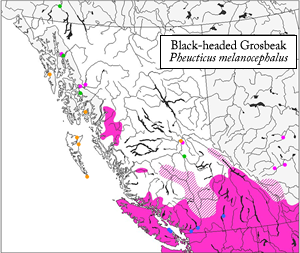Adult males are very distinctive and unlikely to be confused with any other species. Adult females and immatures, however, are very similar to the corresponding plumages of the Rose-breasted Grosbeak and can be easily confused with that species. In most cases, female and immature Black-headed Grosbeaks are overall buffier and more richly-coloured than Rose-breasted Grosbeak, which generally appears browner, and have a distinctly bicolored bill (dark upper mandible) that differs from the more uniformly pale bill (usually with a dusky culmen) of the Rose-breasted Grosbeak. Female and immature Rose-breasted Grosbeak has paler, whiter (sometimes buff-tinged) underparts with extensive heavy dark brown streaks on the breast that extend onto the flanks. Black-headed Grosbeak, by comparison, has a rich buff (almost butterscotch-toned) breast that is largely unstreaked or, at most, has a few very fine dark streaks; these dark streaks are more prevalent on the sides and flanks, but are still much narrower than those of the Rose-breasted Grosbeak. Some immature male Rose-breasted Grosbeaks during their first winter can appear very similar to female Black-headed Grosbeak, however, and are best distinguished by their reddish underwing coverts (yellowish in Black-headed Grosbeak) and bill colour. Immature male Black-headed Grosbeaks acquire rich butterscotch-coloured underparts with little or no streaking during their first winter, and are thus usually readily identifiable even by this age.
Fall migrants are sometimes mistaken for Smith’s Longspur when they appear at feeding stations, but the massive conical bill, dark brown ear coverts, dark brown crown, bold pale supercilium, and overall size of the Black-headed Grosbeak (it is noticeably larger and bulkier than a longspur) should help to eliminate any confusion.
| The song is a whistled series of warbled, ascending or descending phrases or syllables that are separated by brief pauses, often with the impression of alternating rising and falling phrases: toowhi, toowhoo, toowhii, toowhii, phreeuu, towhii, phreeuu. The overall pattern is similar to the song of the American Robin, but the quality of the notes is richer and sweeter and the alternating rising and falling pattern of the phrases is reasonably diagnostic. The song is extremely similar to the song of the Rose-breasted Grosbeak, and in many cases may not be distinguishable, but the phrases average somewhat choppier, faster-paced, and higher-pitched. The most commonly heard call is a high, sharp pik that is similar to the call note of the Rose-breasted Grosbeak but is distinctly lower-pitched and less squeaky; the call may also bring to mind the call note of the Downy Woodpecker, but is higher-pitched and less flat. Also gives a soft, wheezy wheek or wheeet in flight. Sources: Hill (1995); Sibley (2000) |
Courtship
Pair bonds are formed immediately upon arrival on the breeding grounds, sometimes within hours, and pairs remain mated throughout the breeding season. The male courts the female by singing persistently and aggressively in her presence, both from a perch and during short, stiff-winged flights that expose the boldly contrasting pattern of the wings and tail.
Nest
The female constructs the nest alone over a period of 3-4 days soon after arrival on the breeding grounds. The nest itself is an open, bulky, loosely-constructed cup that is situated near the outer branches of a deciduous tree or shrub. It is composed of small twigs, grasses, weed stems, and rootlets and is lined with finer materials such as fine grasses, rootlets, hair, and plant down.
Eggs
A single clutch of (1) 3-4 (5) eggs is laid between mid- to late May and late June or early July, and is incubated by both sexes for 12-14 days before hatching. The smooth, slightly glossy eggs are pale greenish-blue with extensive reddish-brown speckling (often concentrated around the larger end of the egg). Eggs are present in B.C. between mid-May and mid-July. This species is an occasional host for Brown-headed Cowbird nest parasitism.
Young
The young are altricial and downy upon hatching, with pinkish skin and patches of sparse whitish or greyish-white down; the mouth is reddish and the gape flanges are yellow. The young are tended in the nest by both parents for 10-14 days before fledging; the young are unable to fly at fledging, but clamber around the branches near the nest. The young are tended by the parents after leaving the nest, and can fly within ~15 days of fledging. The parents (primarily the female) continue to feed and tend to the young after they are capable of flight, but cease once they have departed the breeding grounds for fall migration. Nestlings and dependent fledglings are present in B.C. between early June and early August.
Source: Hill (1995); Baicich and Harrison (1997); Campbell et al. (2001)
|
The Black-headed Grosbeak feeds extensively on both insects as well as plant foods (berries, fruits, seeds) throughout the breeding season. Insect prey is gleaned from the branches, twigs, and foliage of coniferous and deciduous trees, often high in the canopy, although it occasionally engages in short flights to capture flying insects. Fruits, berries and seeds are plucked directly from the branches of shrubs and trees. This species occasionally visits bird feeding stations during the breeding season or during migration.
Source: Hill (1995)
|
|

